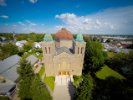On Campus
South CAMPUS
Past is Prologue
Two new architectural programs capitalize on Buffalo’s colorful past and bright future
By Ann Whitcher Gentzke
Tucked away in Buffalo’s Lovejoy neighborhood is a vibrant Russian Orthodox church, a Byzantine beauty still alive with an active congregation. The interior includes gilded murals, copper and stone accents, and a chandelier suspended from a central dome.
Students in UB’s new Advanced Graduate Certificate Program in Historic Preservation recently helped draft a nomination to place Sts. Peter and Paul Orthodox Church on the National Register of Historic Places. Designed by Buffalo architect Joseph Fronczak, the church opened in 1933, replacing a turn-of-the-century structure and welcoming Russian and Eastern European immigrants as it had for decades. The students’ work to document the church’s history, iconography and architecture helped advance the nomination up the chain to the U.S. Department of the Interior, where it was pending at press time.
Students in the recently launched program learn to see preservation as more than saving a building. They’re safeguarding a community’s heritage and, says Ashima Krishna, assistant professor of historic preservation in the School of Architecture and Planning, gaining an understanding of preservation as inseparable from modern urban design. “It really gives you a much more fleshed-out understanding of what you’re going to be dealing with as a preservation practitioner,” she explains. To this end, students delve into topics like the legislative frameworks for preservation and the history of American urbanism.
Also recently introduced is a 48-credit MS degree with a specialization in architectural preservation and urban design—a full-bodied version of the certificate program aimed at generalists. Both programs draw heavily on Buffalo’s built heritage, while welcoming a diverse student body with varied backgrounds, including law, archaeology and journalism.
A bonus for participants is the opportunity to explore Buffalo architecture in depth, says Krishna. “As an architect and a preservation planner, it’s interesting to be part of a city that’s going through such a resurgence, and where preservation is such a big part of that resurgence.”










